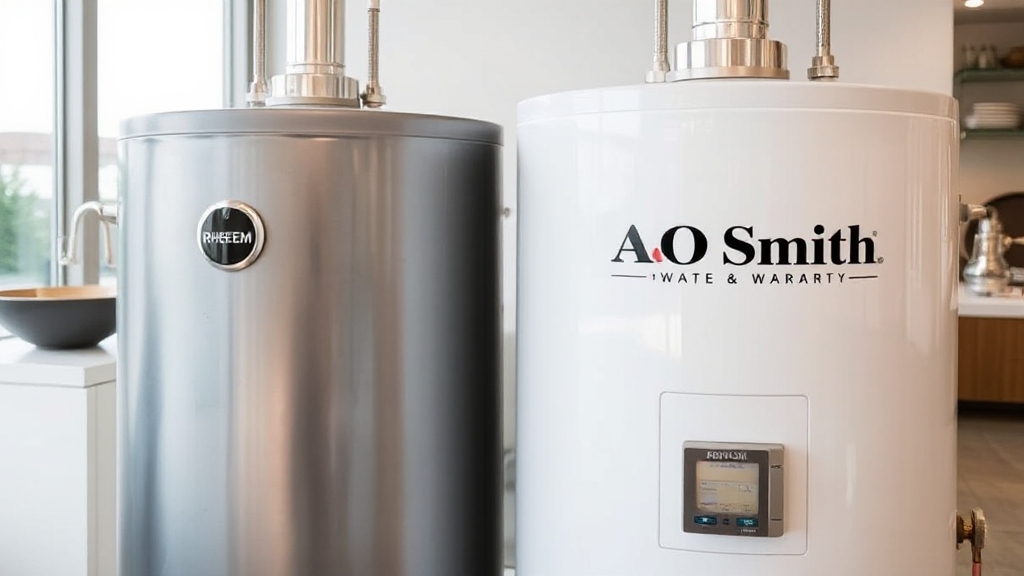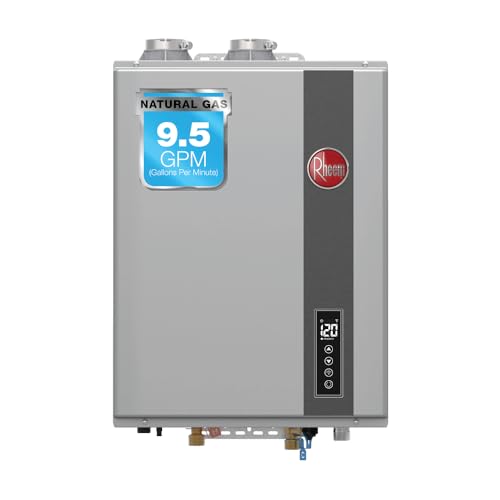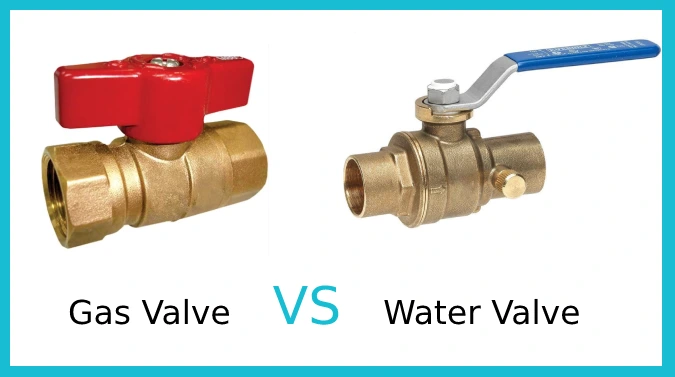Last Updated on May 15, 2025
If you want a gas water heater balancing energy efficiency and durability, Rheem offers higher UEF ratings up to 0.93 and longer services, including lifetime coverage on some models.
Rheem’s smart features and corrosion-resistant materials enhance longevity and reduce maintenance. A.O. Smith typically costs less upfront but may need more repairs over time and has lower efficiency.
To understand how these differences affect your home’s comfort and savings, exploring detailed comparisons will be helpful.
- Flow rate of 0.4 – 9.5 GPM
- Available temperature settings range from 100 to 140F (default setting of 120F)
- Includes electric ignition
- Never run out of water again with a steady 10 GPM flow rate
- Electric ignition ensures you never have to mess with a pilot light again
- This product is Energy Star certified with a Uniform Energy Factor of 0.95
Key Takeaways
- Rheem gas water heaters generally last 12-15 years, longer than A.O. Smith’s typical 10-12 year lifespan.
- Rheem models offer higher energy efficiency with UEF ratings up to 0.93 versus A.O. Smith’s average 0.70.
- Rheem includes advanced features like smart EcoNet connectivity and EverClean self-cleaning technology, reducing maintenance needs.
- A.O. Smith water heaters have a lower upfront cost but may require more frequent maintenance and parts replacement.
- Rheem provides longer warranties, including limited lifetime coverage on select models, enhancing overall value and durability.
Energy Efficiency Analysis
Because energy efficiency directly impacts your operating costs and environmental footprint, comparing Rheem and A.O. Smith gas water heaters is essential.
Rheem models boast higher Uniform Energy Factor (UEF) ratings, reaching up to 0.93, compared to A.O. Smith’s typical 0.70. This translates to annual energy savings exceeding $200 for Rheem users, surpassing A.O. Smith’s approximate $180.
Rheem’s ENERGY STAR certification guarantees compliance with stringent efficiency standards. Additionally, Rheem incorporates low NOx burners and corrosion-resistant magnesium anode rods, enhancing combustion efficiency and durability.
Their Platinum Performance model performs reliably even at high altitudes. Rheem’s EcoNet technology enables real-time monitoring and optimization, maintaining peak efficiency throughout the unit’s lifespan.
Rheem water heaters also offer a longer lifespan of 12-15 years compared to A.O. Smith’s 10-12 years, providing better long-term value.
Technological Features Overview
You’ll find Rheem excels with smart connectivity options like the EcoNet system and leak detection, enhancing control and safety. Both brands offer advanced corrosion-resistant coatings, but Rheem’s EverClean self-cleaning system reduces sediment buildup, lowering maintenance needs.
This self-cleaning system also helps prolong the unit’s lifespan by minimizing sediment-related damage. Understanding these tech differences helps you choose a water heater that balances durability, convenience, and upkeep.
Smart Connectivity Features
Although smart connectivity features vary between Rheem and A.O. Smith, both provide advanced systems enhancing control and efficiency.
Rheem’s EcoNet technology allows you to remotely control and monitor your water heater via smartphone, offering real-time performance data.
A.O. Smith focuses on energy tracking and leak detection with smart alerts, improving maintenance and safety. Both brands support integration with smart home systems, amplifying convenience.
Key features include:
- Remote smartphone control and monitoring (Rheem EcoNet, A.O. Smith apps)
- Real-time alerts for leaks and malfunctions (A.O. Smith’s smart detectors)
- Energy consumption tracking for efficiency optimization (A.O. Smith tankless models)
- Smart home system compatibility for seamless automation
These features empower you with precise management and enhanced operational insight. Notably, the A.O. Smith Signature 900 model also provides Wi-Fi connectivity with leak detection alerts, adding an extra layer of security for users.
Corrosion and Durability Tech
When evaluating gas water heaters, corrosion resistance and durability technologies play a critical role in ensuring long-term performance and reliability.
A.O. Smith employs advanced glass coatings like Permaglas and Blue Diamond, alongside porcelain enamel coatings, to combat corrosion and lime buildup. Their anode rods use a patented process for corrosion protection but may need more frequent replacement.
Additionally, AO Smith emphasizes energy efficiency, with some models designed to reduce operating costs while maintaining durability.
Rheem counters with brass drain valves, enhancing robustness over plastic alternatives, and stainless steel tanks in select models. Both brands integrate corrosion-resistant materials and advanced coatings, but Rheem units generally last longer (12-15 years) compared to A.O. Smith’s 10-12 years.
Additionally, A.O. Smith leverages robotics for precise manufacturing, ensuring consistent build quality. Your choice hinges on balancing corrosion protection methods with expected longevity and service coverage.
Self-Cleaning and Maintenance
Because sediment buildup directly impacts water heater efficiency and lifespan, both Rheem and A.O. Smith incorporate self-cleaning technologies to mitigate this issue.
Rheem’s EverKleen system is particularly effective at reducing sediment accumulation, which enhances the unit’s durability and lowers maintenance frequency. A.O. Smith also offers self-cleaning models, though their effectiveness varies by model and generally requires more frequent upkeep.
Rheem models often feature an electronic gas valve for precise temperature control, which can contribute to overall system efficiency. When maintaining these units, you’ll notice:
- Rheem’s EverKleen reduces sediment flushes and extends service intervals.
- A.O. Smith demands more regular flushing and anode rod inspections.
- Rheem’s designs emphasize user-friendly maintenance access.
- A.O. Smith may require specialized knowledge for proper upkeep.
These features contribute to Rheem’s longer lifespan and sustained efficiency compared to A.O. Smith.
Maintenance Requirements and Longevity
You’ll find Rheem gas water heaters require less frequent maintenance thanks to their EverKleen self-cleaning system, which limits sediment buildup. In contrast, A.O. Smith models often need more regular servicing to manage sediment accumulation, especially in hard water areas.
These maintenance differences directly affect the lifespan and durability, with Rheem units typically lasting longer under similar conditions.
Additionally, Rheem heaters utilize WhiteRogers gas control and simpler thermocoupling, making repairs both easier and less expensive compared to A.O. Smith models.
Maintenance Frequency Differences
Although both Rheem and AO Smith gas water heaters require routine maintenance to guarantee peak performance and longevity, Rheem models demand less frequent hands-on attention thanks to their self-cleaning technology and more durable components.
Rheem’s extended service periods reflect confidence in their low-maintenance design, while AO Smith units, though user-friendly, need more regular manual inspections, especially for anode rod replacements.
Key maintenance frequency differences include:
- Rheem’s self-cleaning reduces sediment buildup, extending intervals between flushes.
- AO Smith requires more frequent anode rod checks due to standard materials.
- Both brands recommend periodic tank flushing, with Rheem’s intervals generally longer.
- AO Smith offers easier access panels for more convenient servicing.
Additionally, considering the service options for both brands can influence maintenance planning and overall satisfaction. Understanding these differences helps optimize maintenance schedules and maximize heater lifespan.
Impact of Sediment Buildup
When sediment accumulates inside your gas water heater, it directly reduces efficiency by limiting tank capacity and forcing the heating elements to work harder. This buildup leads to increased energy consumption and potential premature wear on components.
Regular flushing every six months is essential to mitigate these effects, especially in hard water areas where sediment forms faster. Before starting maintenance, always turn off the water heater to ensure safety during the flushing process.
| Impact Area | Effect |
|---|---|
| Tank Capacity | Reduced due to sediment occupying space |
| Heating Elements | Overworked, leading to early failure |
| Maintenance Frequency | Increased to prevent buildup |
| Energy Efficiency | Decreases as sediment insulates heating |
Lifespan and Durability
Since durability hinges on both design and maintenance, understanding the lifespan and upkeep requirements of Rheem and A.O. Smith gas water heaters is vital. Both brands offer average lifespans of 8 to 12 years for gas tanks, influenced heavily by maintenance and water conditions.
Rheem’s advanced features like Rheemglas lining and brass drain valves enhance durability, while A.O. Smith’s EverKleen technology combats sediment buildup. Proper installation and regular upkeep are essential for maintaining services and extending service life.
Key factors to take into account:
- Services length varies—Rheem up to 15 years, A.O. Smith up to 12 years on high-end models.
- Regular inspection and replacement of anode rods prevent corrosion.
- Flushing tanks reduces sediment accumulation, critical for longevity.
- Quality of valves and tank linings directly impacts maintenance frequency and durability.
Product Range and Model Variety
While both Rheem and Ao Smith cater to diverse needs, Rheem clearly defines its product range with detailed specifications across residential and commercial gas water heaters, offering various capacities, efficiency ratings, and configurations.
Rheem residential models range from 48 to 98 gallons, with efficiency factors between .49 and .62 and recovery rates of 45.5 to 75.8 GPH at a 90°F rise. Rheem’s commercial units scale from 500,000 to 715,000 BTU/h, delivering up to 756 GPH, with versatile mounting options and scalable multiple-unit systems.
Additionally, Rheem is recognized as a global leader in water heater manufacturing, which underscores its extensive expertise in this field. Rheem offers residential tanks from 48 to 98 gallons and commercial units delivering up to 756 GPH.
Ao Smith also offers a broad selection, emphasizing advanced efficiency and environmental compliance, but specific capacity and recovery data are less detailed.
Both brands incorporate innovative technologies and meet environmental standards, ensuring you have technically advanced and compliant options for residential and commercial applications.
Performance in Real-World Use
When evaluating gas water heaters, you’ll find that Rheem’s self-cleaning system considerably reduces sediment buildup, enhancing both reliability and lifespan. This feature, combined with superior build quality, allows Rheem models to last between 12 to 15 years with proper maintenance.
In contrast, A.O. Smith heaters typically require more routine upkeep and average 10 to 12 years in service. Rheem’s higher Uniform Energy Factor (UEF) ratings—up to 0.93—and Econet technology offer real-time energy monitoring, enabling you to optimize usage and achieve greater annual savings, potentially exceeding $200.
Rheem’s superior UEF ratings and Econet tech enable smart energy use and notable yearly savings. Although A.O. Smith provides reliable performance and robust services coverage, its models often deliver slightly lower energy efficiency and fewer advanced features.
Additionally, Rheem water heaters are generally easier and cheaper to repair due to their use of simpler thermocoupling and more affordable repair kits.
Noise Levels and User Comfort
Because noise markedly affects user comfort, evaluating the sound levels of Rheem and AO Smith gas water heaters is essential. Rheem generally operates quieter, with some models registering 56 dBA up close but dropping to 34 dBA in adjacent rooms.
In fact, personal experience has shown that the Rheem heat pump is notably quieter than AO Smith. AO Smith’s latest heat pump models cap at 45 dBA, complying with NEEA Tier 4 noise standards.
Fan direction and vibration control also impact perceived noise. Consider these factors:
- Rheem’s fan directs air backward, reducing noise impact.
- AO Smith integrates vibration-minimizing designs for quieter operation.
- Insulation and strategic placement can lower noise further.
- User sensitivity and installation location affect comfort perception.
Environmental Impact and Sustainability
As you evaluate gas water heaters from Rheem and AO Smith, understanding their environmental impact and sustainability is essential. Both brands’ gas models emit carbon dioxide, contributing to greenhouse gases due to fossil fuel combustion.
Rheem’s higher UEF ratings and Econet energy monitoring improve efficiency, reducing emissions and saving you up to $200 annually. Rheem units also tend to last longer, minimizing waste.
Additionally, choosing models with Energy Star certification can significantly enhance energy savings and reduce environmental footprint. Rheem’s superior efficiency and energy monitoring cut emissions and save you up to $200 annually.
However, moving to heat pump water heaters, which both brands offer, considerably curtails carbon output—potentially cutting over 2,000 pounds of CO2 yearly—making them more sustainable choices as electricity grids become greener.
Regular maintenance, including anode rod replacement, extends lifespan, further lessening environmental impact.
Therefore, selecting a high-efficiency model or shifting to heat pump technology aligns with sustainability goals while optimizing performance and cost savings.
Frequently Asked Questions
Are Rheem and A.O. Smith Water Heaters Compatible With Solar Water Heating Systems?
Just like a well-crafted symphony, integrating solar water heating requires harmony between components. You’ll find that both Rheem and A.O. Smith offer solar-compatible water heaters designed for seamless integration with solar thermal systems.
Their products include complete solar kits and tanks in standard sizes, enabling you to retrofit or install efficient solar setups. With tools to guarantee compatibility, you can confidently enhance your system’s energy savings through their innovative, solar-ready solutions.
Which Brand Offers Better Customer Service and Support Responsiveness?
You’ll find that Rheem offers more responsive customer service, resolving issues swiftly and following up to guarantee satisfaction. Their quick complaint handling and extended program add value.
AO Smith provides solid support with accessible contact options and technical assistance, but some users report slower response times.
Both brands maintain extensive online resources and consistent service, yet Rheem’s reputation for customer support responsiveness is generally more favorable in the market.
Do Either Rheem or A.O. Smith Water Heaters Have Built-In Freeze Protection?
You’ll find that Rheem water heaters include built-in freeze protection using electrical heating elements, safeguarding internal components down to -20°F (-28°C) when powered. However, this doesn’t cover external pipes or valves.
A.O. Smith water heaters lack clearly documented freeze protection features, so you’ll likely need external insulation or heating for freeze-prone areas. In either case, proper installation and power supply are essential to guarantee effective freeze prevention.
Can These Water Heaters Be Installed in Outdoor or Unconditioned Spaces Safely?
You shouldn’t install standard gas water heaters in outdoor or unconditioned spaces unless they’re specifically rated for such environments.
Doing so risks freezing damage and may violate local codes. Proper venting and placement away from combustibles are critical for safety.
If outdoor installation is necessary, choose a model designed for that purpose, equipped with weatherproofing and freeze protection, and guarantee a qualified professional handles the venting system.
Are There Significant Differences in Installation Complexity Between Rheem and A.O. Smith?
You’ll find installation complexity varies based on design features and venting options. Some units offer flexible venting and side water connections, simplifying placement and hookups.
Others may require specific venting configurations or additional parts, increasing complexity. Your choice impacts maintenance frequency too.
Advanced designs with durable components can reduce installation challenges and upkeep. Understanding these factors helps you plan installation efficiently and maintain peak performance over time.
Choosing Comfort and Savings: Efficiency Ratings Matter
Choosing between Rheem and AO Smith gas water heaters is like picking the right engine for your home’s heartbeat. Both deliver reliable performance and energy efficiency, but your choice hinges on specific needs—whether you prioritize cutting-edge technology, quieter operation, or long-term cost savings.
By weighing services, maintenance, and environmental impact, you’ll find the heater that powers your comfort with precision and durability, ensuring a steady flow of warmth without compromise.
- High-efficiency tankless gas water heater delivers up to 8.4 GPM, perfect for 2–3 bathroom homes…
- Powered by natural gas with 180,000 BTUs, this durable tankless unit ensures fast, reliable hot…
- Designed for outdoor installation, this high-efficiency tankless natural gas water heater features a…
- Meets or exceeds the thermal efficiency and/or standby loss requirements
- Electronic Ignition
- CSA Certified and ASME Rated TandP Relief Valve
Last update on 2025-12-29 / Affiliate links / Images from Amazon Product Advertising API







